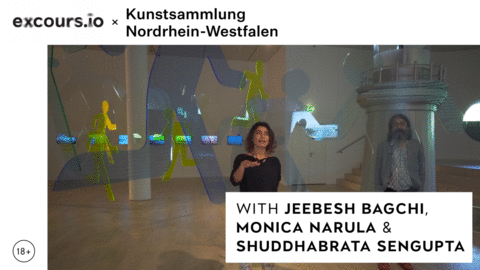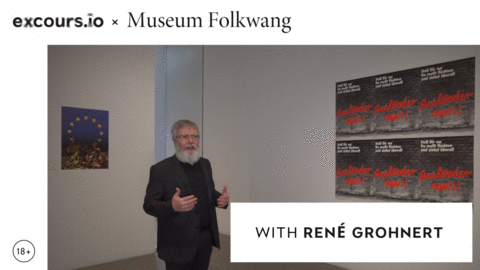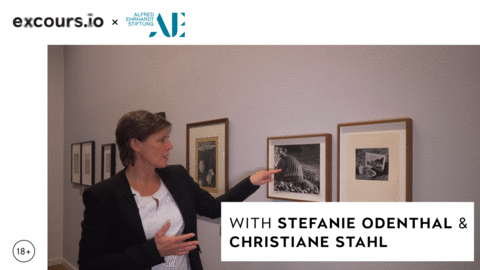Raqs Media Collective. Everything Else is Ordinary
Why should you watch this?
The Raqs Media Collective’s exploration of time as a force shaping human experience offers a profound critique of how society functions under capitalism. Their works challenge traditional notions of time, revealing its role in regulating life and framing historical narratives. By dismantling these fixed interpretations, they invite audiences to rethink the ways time is measured, experienced, and manipulated. In doing so, their practice merges art, history, and philosophy, making their work a compelling reflection on the rhythms that shape our individual and collective existence.
Klaus Staeck. Sand for the Gears
Why should you watch this?
Klaus Staeck’s exhibition resonates deeply with contemporary audiences, serving as a powerful reminder of art’s capacity to provoke thought and inspire social change. In an age marked by political polarization and social unrest, Staeck’s nearly 180 posters challenge us to confront uncomfortable truths and reflect on the role of dissent in shaping public discourse. His bold, often scandalous imagery speaks to the importance of artists as catalysts for conversation, urging society to engage with pressing issues such as inequality, identity, and civic responsibility. As we navigate our own crises today, Staeck’s work underscores the timeless relevance of art as a tool for advocacy and a vehicle for sparking new dialogues. This exhibition not only honors a pivotal figure in art history but also invites us to consider how we, too, can use creativity to effect change in our communities.
Nautilus – Snails, Shells, and Mollusks in Photography
The exhibition delves deep into the captivating world of shells and snails as seen through the lenses of iconic modern photographers like Edward Weston and Imogen Cunningham. This pioneering showcase assembles a rich tapestry of images, tracing humanity’s longstanding fascination with these natural forms—from their mathematical elegance to their cosmic symbolism. Grounded in Alfred Ehrhardt’s seminal works, including his influential books “Muscheln und Schnecken” and “Geprägte Form,” the exhibition also highlights the intersection of art and science, featuring innovative techniques like X-ray photography and the New Objectivity movement. Beyond mere visual appeal, the show offers an exploration of cultural significance, inviting viewers to reflect on the beauty and complexity of these “structural forms in nature,” culminating in the screening of Ehrhardt’s award-winning film “Tanz der Muscheln.”
Why should you watch this?
The exhibition at the Alfred Ehrhardt Foundation serves as a timely reminder of the profound connection between art, nature, and cultural history, inviting contemporary audiences to reflect on our relationship with the natural world. In an era increasingly defined by technology and rapid change, this exploration of shells and snails highlights the enduring allure of organic forms, encouraging a return to appreciation for the intricate beauty found in nature. By showcasing how modern photographers have captured these motifs—often imbued with deep symbolic significance—the exhibition underscores the relevance of natural elements in contemporary art and design, prompting discussions about sustainability and the need for mindful engagement with our environment. Furthermore, the intersection of art and science represented in this collection resonates with current dialogues on ecological awareness, reminding us that aesthetic appreciation can foster a deeper understanding of the world we inhabit.
Clemens von Wedemeyer – Mehrheiten [Majorities]
The exhibition critically examines the evolution of mass mobilization and crowd dynamics in both historical and contemporary contexts, drawing inspiration from Elias Canetti’s “Crowds and Power.” Set against the backdrop of the GfZK’s new architectural space, the exhibition engages with the complexities of collective action, exploring how digital public spheres shape democratic participation while simultaneously being exploited for exclusionary practices. Featuring a rich array of video installations and cinematic works, including the new production “70.001,” which reimagines the 1989 Leipzig demonstrations, “Majorities” invites reflection on the nuances of social behavior and the implications of simulated experiences in gaming and surveillance. Through this thoughtful presentation, Wedemeyer prompts us to consider the intertwining narratives of isolation and community, resonating powerfully in today’s fragmented society.
Why should you watch this?
Watching this guided tour is crucial in our current landscape marked by digital polarization and the resurgence of mass movements. As societies grapple with issues of identity, representation, and exclusion within online spaces, this exhibition offers a vital framework for understanding how crowd dynamics shape our collective psyche and political discourse. In an age where social media can amplify divisive ideologies, gaining insights into the historical and psychological underpinnings of mass mobilization is essential. The tour encourages participants to critically examine how these dynamics operate today, heightening awareness of the fine line between community engagement and manipulation. By exploring these themes, viewers are invited to reflect on their agency within the digital public sphere, making the experience not just an exploration of art and history, but also a compelling call to engage thoughtfully in the ongoing dialogue about democracy and social responsibility in our interconnected world.




![Clemens von Wedemeyer – Mehrheiten [Majorities] Clemens von Wedemeyer – Mehrheiten [Majorities]](https://cloud.excours.io/film-previews/clemens-von-wedemeyer.gif)
